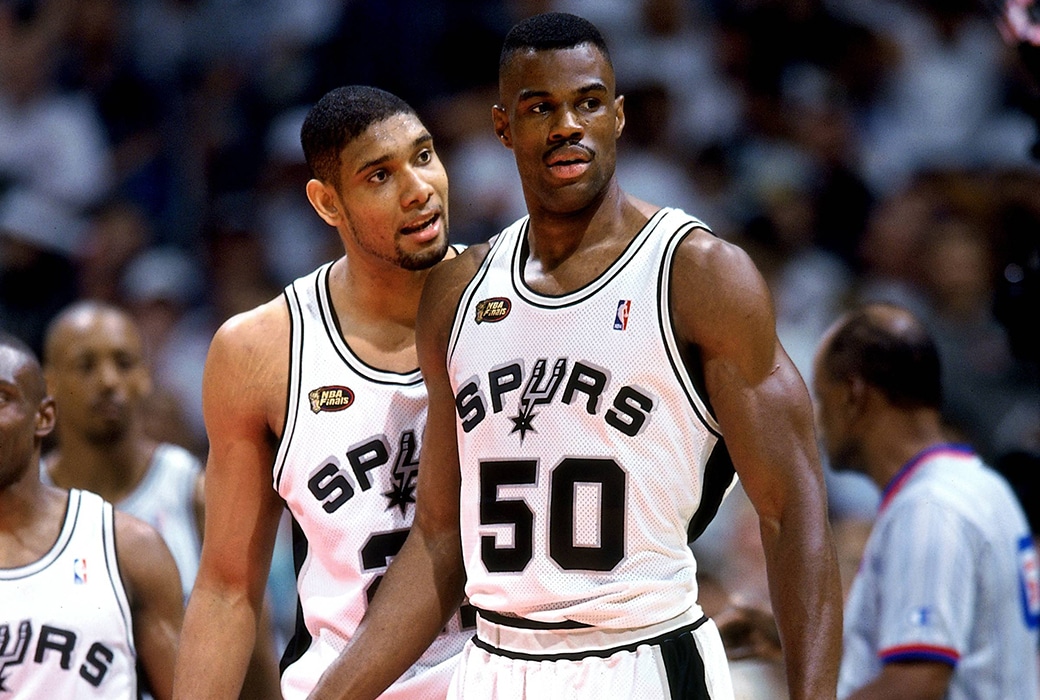
- Mania Madness II – The Finals - April 1, 2024
- Norm Of The North – 2023 AFC North Preview - September 4, 2023
- Gold For Gold – Denver Nuggets NBA Finals Preview - June 1, 2023
Welcome back! If you’re still with me after parts one and two of this strange NBA thought experiment, Thank You.
In part one we discussed how nostalgia alters our memories of bygone sports eras and in part two we looked at how the average player has improved since the 1990s, while pace and scoring have remained about the same, despite what some would have you believe.
I’ve had this debates about the 1990s versus the modern NBA with many over the years but most recently with 3 Point Conversion founder and owner, the one and only Mr. Controversy, Raphael Haynes.
In most of these debates, he likes to remind me that “modern players don’t have the same fundamentals.”
Well, with all due respect, Boss, Part three is about why that is incorrect. In your own infamous words: “stop it!”
Part 3: The Fundamental Flaw
Saying that the modern NBA players don’t have fundamentals is a go-to argument of those defending the old school. There is a reason for this.
First off, it makes you sound like you’re a basketball intellectual, especially to anyone younger than you. And for some reason, we just accept that answer. “Thank you wise basketball man!” we yell as he wanders off, Uncle Drew-like, looking for the next group of young bloods so he can learn them a thing or two.
Anybody ever notice nobody ever actually defines what exactly “fundamentals” means?
It’s vague but it sounds sophisticated. It’s the basketball debate equivalent of “oh, you wouldn’t understand.”
If you paid attention in parts one and two, you’ll know where I’m going with this. What is considered a “fundamental” is as fluid and subjective as everything else.
If you Google “basketball fundamentals” you’ll find varying but similar lists as to what skills comprise the fundamentals. Generally speaking, you’ll see layups, shooting, foul shooting, passing, dribbling, screening/cutting, post moves, rebounding and defense.
Now, yesterday, we talked heavily about shooting and the proof is pretty undeniable statistically: modern NBA shooters are better at both general shooting and free throw shooting than they were in the past. That’s two of the most major fundamentals, which players are objectively better at today.
Yesterday we also discussed defense, which will be examined more fully tomorrow. But we also established yesterday that possessions per game and points per game from the 1990s compared to now are largely the same. So if possessions and point totals are basically static but shooting percentages have gone up, what does that say about defense?
The inconvenient truth is that it actually shows defenses are better now than they used to be. Teams are shooting better but it isn’t translating to higher point totals because despite what many will tell you, the defenses are actually performing better overall throughout the league.
Without question, defense is less physical than it was in the 1990s but that doesn’t make the defense bad. Physical defense is not inherently good in and of itself. Defenses now are significantly more sophisticated, require more switching and with the increased range of shooters, players have to defend more court than ever before.
Those who decry this era for not having defense don’t actually miss defense, they miss seeing guys get hit in the face for attempting a layup.
So we can take the shooting and defense fundamental arguments and pretty much immediately throw those away. If you still think those fundamentals are lacking that’s your subjective (i.e. personal) opinion. Objectively (factual), it just isn’t true. You may have liked the 90s style of things more but that does not make them better.
Now, to be sure, certain fundamentals are lacking compared to the 90s. In particular, post moves have really disappeared. Post footwork is a lost art. The 90s of course had an embarrassment of elite centers, including Hakeem Olajuwon, one of the two greatest post-footwork players ever (alongside Kevin McHale).
In the modern NBA almost no center has them. Joel Embiid does, when he feels like it. He occasionally pulls a move that is Olajuwon-esque. Domantas Sabonis of the Indiana Pacers has a pretty textbook drop-step down low but considering who his father is, that shouldn’t be a surprise.
So yes, some fundamentals have been lost. But if post footwork has lessened and shooting and defense have improved, do we have less fundamentals? No, we don’t. Their distribution may have been shifted but fundamentals are alive and well.
Let’s look at two others that I feel go hand in hand: passing and dribbling. Together, they speak to ball security. Solid fundamentals in those areas will lead to increased possessions and increased chances to win. If the fundamentals were so much better in the past, surely they must have turned the ball over less, right?
Between 1990 and 1999, NBA teams turned the ball over an average of 14 times per 100 possessions. Between 2010 and 2019, teams turned the ball over an average of 13 times per 100 possessions. As players have gotten better so too has ball security. If modern players lacked fundamentals, how are they possibly turning the ball over less than the players that supposedly had fundamentals?!
The answer, of course, is they have fundamentals today as well. Players just naturally get better over time. Turnover percentage started being tracked in the 1973-74 season. Since then, the number of turnovers per 100 possessions has been steadily dropping (it was 17% in 1974), which should come as no surprise.
Well what about rebounding? For the 1990s, teams averaged 42 rebounds per game. For the 2010s, it was 43. So we’re seeing a slight bit more rebounding than we did in the 90s.
For those keeping track at home, so far the argument that players lack “fundamentals” has failed the test on shooting, passing, dribbling, defense and rebounding. But hey, at least it got a win in post footwork!
More anecdotally, we can outright dismiss that players lack the fundamentals of cutting and screening. Go watch the Golden State Warriors offense, (in particular in 2015-2016, prior to when Kevin Durant’s more isolation heavy brand came to town) and you will see those “fundamental” skills are alive and well.
So why do people keep claiming this?
Part of it is that there is not a rigid definition of “fundamentals.” What is and is not a fundamental skill evolves and changes along with the game itself.
Perhaps the two most fundamental skills we learn as basketball players at a young age are dribbling and the jump shot. But interestingly, neither of those things were considered fundamentals at one point in time, until eventually they were as fundamental as running.
When James Naismith first invented basketball, dribbling wasn’t even part of the game. The ball could only be moved by passing. Eventually, players on early barnstorming teams in the 1910s found themselves receiving a pass and being trapped by two or three defenders.
These players quickly learned that by “fumbling” the ball and picking it back up they could escape the trap. This quickly evolved into the dribbling we take for granted as a fundamental building block of the sport.
Joe Fulks was a professional player who played for the then Philadelphia Warriors from 1946 to 1954. He was considered one of the premier offensive threats of the young NBA. He was known as “Jumpin Joe” because of his odd habit of jumping during his field goal attempts.
Sounds weird, right? That’s because, prior to Fulks, professional players shot set shots where their feet didn’t leave the ground. The set shot was considered to be an absolutely fundamental skill. Until Fulks pioneered a more effective skill and the set shot was largely left in the past.
In the early days of the sport, there’s tangible proof that the concept of fundamental skills is fluid, not rigid. Something is fundamental until it isn’t. Some fundamentals come from innovation, such as the dribble, while others come from improvement of an already establish skill, such as the jump shot.
It’s easy to dismiss those early changes though. They happened in the distant past, when the game was still in its infancy. But these same types of innovations still occur, they’re just more subtle.
When I was learning the game as a kid, I remember being taught how to run a fast break. Go wide, make the defender commit, get a layup. There was some freedom in what angle you attacked from but ultimately you went to the basket.
At the same time I was being taught that as an absolute fundamental, an NBA player of the 90s was changing that. And no, it wasn’t Michael Jordan, or John Stockton or any other legend. It was one of those average guys, Dennis Scott.
I was a big fan of the mid 90s Orlando Magic. They were fun, exciting and Shaquille O’Neal was my first favorite player. I watched a lot of Magic games. And I noticed Dennis Scott did something nobody else did: on a fast break, he would often run all the way to the corner to get an open look for three.
Now this flew in the face of every fundamental I had learned about the fast break. But for Dennis Scott, shooting threes was a fundamental skill of his. He didn’t change the fundamentals of the fast break, he just expanded them.
Now, running to the open corner happens in any game on any given night. It’s further expanded to the transition pull up three. These are considered fundamental parts of the modern NBA fast break but they would be considered blasphemy to players in the 1980s.
That’s ultimately the point here. What is and is not a fundamental is all based on circumstance, style of play, individual talent. Remember when Tyson Chandler started back-tapping rebounds out to his guards when he couldn’t get a clean one? Same idea. A new skill he developed. It didn’t replace standard rebounding, it just gave him more tools in his tool belt.
Complaining about fundamentals isn’t some new phenomenon, either. In the very early 60s the NBA saw a statistical boom (more on that tomorrow) in particular from guys like Wilt Chamberlain, Oscar Robertson, Elgin Baylor and Jerry West. Old timers then denounced this as a lack of fundamentals as well.
In 1961 then Detroit Pistons coach Dick McGuire said “The kids are making shots we wouldn’t dare take. The science is going out of the game and its becoming dull.” Does that sound familiar to some of the complaints about today’s game?
The players McGuire was coaching still had fundamental skills but the game had evolved. Their fundamental skills weren’t the same as the ones he learned. That doesn’t make them any less important or more important. Fundamentals differ with eras.
Would anyone have taught you to shoot a three from five feet behind the three point line even 15 years ago? Of course not, that would be crazy. That would go against fundamentals.
But for guys like Steph Curry, Klay Thompson, Damian Lillard or Trae Young, shooting from the logo is a fundamental skill.
So when you say “today’s game lacks fundamentals” what you’re really saying is “today’s game lacks the fundamentals as I define them.” But the game doesn’t belong to you or me, there is no true definition of what a fundamental skill is.
They change and evolve and through that process, the game advances and survives. If you don’t believe that, just ask yourself: would you tune in to watch if guys still shot flat-footed set shots and weren’t allowed to dribble?
Tomorrow we’ll bring this whole thing full circle, literally.




